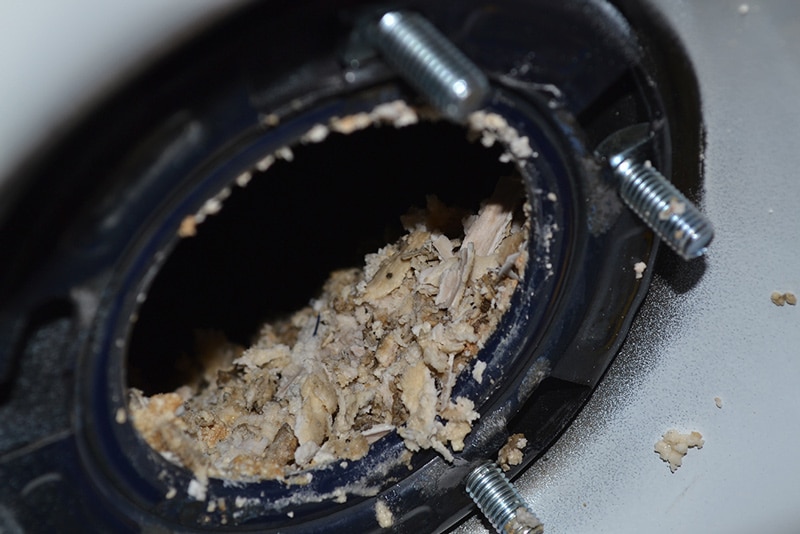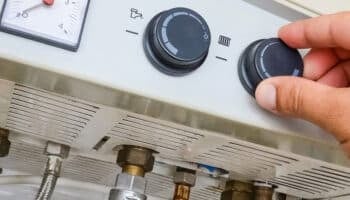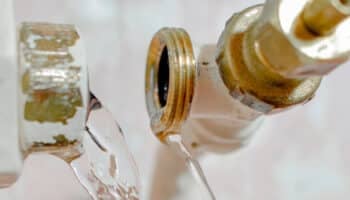We've independently reviewed this article to make sure it's as accurate as we can make it.
To find out more about our article creation and review process, check out our editorial guidelines.
Is your hot water suddenly too hot? It might be a good idea to turn your heater off and clean it. Here are 5 potential causes & fixes.
Having your water heater fail is probably one of the most inconvenient things you can have happening to you. You can’t do the dishes, you can’t wash your hands, you can’t even take a proper shower without getting scalded.
Does this sound like you? I get it, trust me, I do.
This unfortunate occurrence happens every year to thousands of people all over the world and is actually much more common than you’d think. In fact, if your water heater has seen some seasons, this is not only likely to happen, but even bound to.

There are many reasons why you could be experiencing this. From mineral buildup to a broken thermostat, it’s really anyone’s guess. That is if you don’t have a comprehensive list to refer to. But you do. Relax, you and your family can rest easy now.
Below, you’ll find a compendium of the possible culprits and solutions to address them. I promise that, by the end of it, at the very least, you’ll know exactly what’s wrong and the next steps to take.
Are you ready? Let’s get that water heater under control!
Your Water Heater Might Be Getting Too Hot Due To…
- Incorrect temperature settings
- A bad thermostat
- High mineral buildup
- A blocked pressure relief valve
- A faulty heating element
Throughout this article, we’ll cover the causes behind these issues for both gas, and electric water heaters, as they might share some common ailments, but differ greatly in other areas.
Most Common Issues
#1 Temperature Set Too High
Check your temperature dial
This might seem like something obvious, but you’d be surprised at how many times this is the reason behind the water in your home getting too hot. If your water heater was recently serviced, or you had to open it for maintenance, the temperature dial could have been accidentally turned.
When it comes to water heaters and temperature, even the slightest movement in the temperature dial can result in changes you’ll definitely notice.
Solution: Check your water heater’s temperature dial.
You can use a screwdriver to open the external casing and expose it. If your heater is electric, please be sure to unplug it before tampering with it.
Once you see the component, set it to 115-120 °F for optimal water temperature.
#2 Your Thermostat Is Failing
Your thermostat could be sensing temperature incorrectly
So, you opened your water heater, only to find that the temperature was set correctly. What now? There’s a good chance that, if this is the case, the issue might not be related to external temperature regulation, but detection and control from the inside.
Within every water heater, there are two thermostats responsible for measuring the heat and controlling it by sending signals to other components. As you can imagine, when they fail, these readings are all wrong, and thus, so is the regulation.
If you suspect this to be the issue, you should try and address it right away, as no temperature dial changes will help.
Solution: Depending on how confident you feel around these appliances, you have two options. Call a technician, or test the thermostat yourself.
If you choose the latter, please make sure to unplug your electric water heater, or close the gas nozzle feeding your gas unit entirely to avoid gas leaks and other potentially dangerous situations.
The first thing you want to check is that your thermostat is making direct contact with your water heater’s body, as this will guarantee optimal temperature detection and regulation. If that did not fix the issue, follow these steps:
- Find the plate covering your water heater’s internal components (it looks like a big metal rectangle)
- Undo the screws holding it in place to expose the appliance’s guts
- Find your thermostats and remove them
- If you have a multimeter, test them for conductivity
If there is no conductivity, you’ll have to buy a replacement. This will enable your water heater to adequately sense its temperature again, and take care of your boiling-hot water problem.
#3 There’s Mineral Buildup
Keep your pipes clean and clear
While the time it takes for this problem to manifest itself will vary depending on where you live and the mineral content in your area’s water, sooner or later, it’s going to affect all of us.
As time goes by, water passing through your water heater leaves small traces of minerals that eventually form sediment deposits in your piping. These make it difficult for your appliance to operate properly, create heat, and regulate the temperature inside it.

On both electric and gas water heaters, the most affected parts are the tubes through which the water runs, but the former also sees deterioration in the heating element, which makes the problem even more severe.
Solution: This can all be prevented by making sure to give your water heater proper maintenance at least once every two years.
If you feel confident, you can try and do some pipe cleaning yourself, but it’s usually best to have a technician do it, as it will not only keep your warranty intact, but also save you some trouble.
A common long-term solution for this is to use anode rods, which act as a magnet for deposits to stop them entering the heater of the element. If mineral buildup is a regular issue for you, you could talk to a professional about installing anode rods to help protect your water heater.
Gas Heater Pressure Relief Valves
This is arguably the most important part of your water heater
Gas heaters use fire and pressure to bring your water to the temperature of your choosing, but what happens to all pressure afterwards?
These appliances are built with little devices called pressure relief valves, which, as you can probably guess, are responsible for releasing the excessive build up and keeping your water heater from exploding.
When this valve is obstructed, corroded or compromised in any way, your water heater becomes unable to dissipate the accumulated pressure, causing your water to get extremely hot.
When your pressure relief valve is blocked, water temperature should be the least of your worries. If you suspect this to be the issue, it is extremely important that you turn your water heater off immediately, as failing to do so could put you and your family in a very dangerous situation.
Solution: For this one, it’s advised to call a technician, as there are many complicated steps that are best taken care of by a professional.
Please do not leave this issue unattended, as it could have catastrophic consequences.
Electric Heater Heating Elements
Your heating element might be corroded
As opposed to gas water heaters, these electric variants rely on a metal component called the heating element, which, as its name suggests, is responsible for generating the heat that will increase your water’s temperature.
How does it work?
Heating elements are designed to take electrical energy and transform it into usable heat by focusing it through a series of metal coils. This increases the appliance’s internal temperature and that of the water that runs through them (usually 2 in a water heater).
If your hot water is suddenly too hot, there’s a hance that this component is failing, either due to corrosion and sediment buildup around it, or being broken altogether. Typically this will fail when off, but there’s a small chance it can fail while still being turned on.
Solution: I strongly advise calling an expert for this procedure, as it involves tampering with the pressure relief valve and near-boiling hot water.
That being said, if you must attempt to fix this yourself, please do so with all the possible safety precautions in mind, and at your own risk!
The steps to follow are:
- Cut off power and water supply to your water heater
- Remove the outer metal casing to expose the appliance’s internal components
- Use a multimeter to double-check there is no electricity passing through them
- Connect one end of a garden hose to the pressure relief valve, and place the other end near a drain
- Turn the valve’s release system counterclockwise to drain the water inside the tank
- Disconnect the two wires connected to the screws holding the heating element in place
- Unscrew the screws
- Remove the old heating element and place in the new one
- Put everything back together and test your water heater
If you’re a visual person like me, there are a few online videos you can check out and follow along.
- How to Know if a Hot Water Heater Element Needs to Be Replaced
- D.I.Y. How to Replace the Heating Eements in Your Hot Water Heater
- Change a Hot Water Heater Element Without Draining or Spilling Water
Conclusion
Having your hot water suddenly get too hot can be a major inconvenience. We never really consider how important water is around the house until we can no longer use it comfortably.
There can be many reasons behind your water temperature issue, but fortunately, most of them can be fixed without going through too much trouble. That being said, there are some that are more urgent than others.
A broken or blocked pressure relief valve should be addressed immediately, and not taken lightly. Even if that means having to shower with cold water for a while. It’s better to have your water heater non-functional than exploding.
Remember that, like many other household appliances, water heaters need constant maintenance to function properly and extend their lifespan.
While gas and electric heaters operate differently, neglecting them will always result in trouble. It’s not a bad idea to take some time every year to make sure your pipes are free of corrosion and your thermostats are working normally.
Lastly, I want to stress again how important it is to ask for help when you feel overwhelmed. I commend you for trying to do your own repairs and learning something new, but water heaters are no joke.
Please call a technician you trust when trying to check your pressure relief valve or replacing your heating element, as the processes are very complex, and any missteps could put you in danger.
I know you want to learn, and you can still do it by watching the professionals work. Keep safety as a top priority. Always.
Thank you so much for reading. If you feel like you learned something valuable today, why not keep expanding your knowledge with our other resources below?







